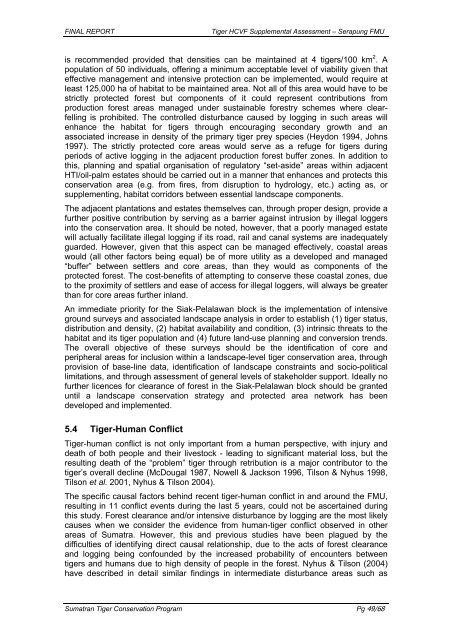A Supplemental HCVF Assessment on the Sumatran Tiger ...
A Supplemental HCVF Assessment on the Sumatran Tiger ...
A Supplemental HCVF Assessment on the Sumatran Tiger ...
You also want an ePaper? Increase the reach of your titles
YUMPU automatically turns print PDFs into web optimized ePapers that Google loves.
FINAL REPORT <strong>Tiger</strong> <str<strong>on</strong>g>HCVF</str<strong>on</strong>g> <str<strong>on</strong>g>Supplemental</str<strong>on</strong>g> <str<strong>on</strong>g>Assessment</str<strong>on</strong>g> – Serapung FMU<br />
is recommended provided that densities can be maintained at 4 tigers/100 km 2 . A<br />
populati<strong>on</strong> of 50 individuals, offering a minimum acceptable level of viability given that<br />
effective management and intensive protecti<strong>on</strong> can be implemented, would require at<br />
least 125,000 ha of habitat to be maintained area. Not all of this area would have to be<br />
strictly protected forest but comp<strong>on</strong>ents of it could represent c<strong>on</strong>tributi<strong>on</strong>s from<br />
producti<strong>on</strong> forest areas managed under sustainable forestry schemes where clearfelling<br />
is prohibited. The c<strong>on</strong>trolled disturbance caused by logging in such areas will<br />
enhance <strong>the</strong> habitat for tigers through encouraging sec<strong>on</strong>dary growth and an<br />
associated increase in density of <strong>the</strong> primary tiger prey species (Heyd<strong>on</strong> 1994, Johns<br />
1997). The strictly protected core areas would serve as a refuge for tigers during<br />
periods of active logging in <strong>the</strong> adjacent producti<strong>on</strong> forest buffer z<strong>on</strong>es. In additi<strong>on</strong> to<br />
this, planning and spatial organisati<strong>on</strong> of regulatory “set-aside” areas within adjacent<br />
HTI/oil-palm estates should be carried out in a manner that enhances and protects this<br />
c<strong>on</strong>servati<strong>on</strong> area (e.g. from fires, from disrupti<strong>on</strong> to hydrology, etc.) acting as, or<br />
supplementing, habitat corridors between essential landscape comp<strong>on</strong>ents.<br />
The adjacent plantati<strong>on</strong>s and estates <strong>the</strong>mselves can, through proper design, provide a<br />
fur<strong>the</strong>r positive c<strong>on</strong>tributi<strong>on</strong> by serving as a barrier against intrusi<strong>on</strong> by illegal loggers<br />
into <strong>the</strong> c<strong>on</strong>servati<strong>on</strong> area. It should be noted, however, that a poorly managed estate<br />
will actually facilitate illegal logging if its road, rail and canal systems are inadequately<br />
guarded. However, given that this aspect can be managed effectively, coastal areas<br />
would (all o<strong>the</strong>r factors being equal) be of more utility as a developed and managed<br />
“buffer” between settlers and core areas, than <strong>the</strong>y would as comp<strong>on</strong>ents of <strong>the</strong><br />
protected forest. The cost-benefits of attempting to c<strong>on</strong>serve <strong>the</strong>se coastal z<strong>on</strong>es, due<br />
to <strong>the</strong> proximity of settlers and ease of access for illegal loggers, will always be greater<br />
than for core areas fur<strong>the</strong>r inland.<br />
An immediate priority for <strong>the</strong> Siak-Pelalawan block is <strong>the</strong> implementati<strong>on</strong> of intensive<br />
ground surveys and associated landscape analysis in order to establish (1) tiger status,<br />
distributi<strong>on</strong> and density, (2) habitat availability and c<strong>on</strong>diti<strong>on</strong>, (3) intrinsic threats to <strong>the</strong><br />
habitat and its tiger populati<strong>on</strong> and (4) future land-use planning and c<strong>on</strong>versi<strong>on</strong> trends.<br />
The overall objective of <strong>the</strong>se surveys should be <strong>the</strong> identificati<strong>on</strong> of core and<br />
peripheral areas for inclusi<strong>on</strong> within a landscape-level tiger c<strong>on</strong>servati<strong>on</strong> area, through<br />
provisi<strong>on</strong> of base-line data, identificati<strong>on</strong> of landscape c<strong>on</strong>straints and socio-political<br />
limitati<strong>on</strong>s, and through assessment of general levels of stakeholder support. Ideally no<br />
fur<strong>the</strong>r licences for clearance of forest in <strong>the</strong> Siak-Pelalawan block should be granted<br />
until a landscape c<strong>on</strong>servati<strong>on</strong> strategy and protected area network has been<br />
developed and implemented.<br />
5.4 <strong>Tiger</strong>-Human C<strong>on</strong>flict<br />
<strong>Tiger</strong>-human c<strong>on</strong>flict is not <strong>on</strong>ly important from a human perspective, with injury and<br />
death of both people and <strong>the</strong>ir livestock - leading to significant material loss, but <strong>the</strong><br />
resulting death of <strong>the</strong> “problem” tiger through retributi<strong>on</strong> is a major c<strong>on</strong>tributor to <strong>the</strong><br />
tiger’s overall decline (McDougal 1987, Nowell & Jacks<strong>on</strong> 1996, Tils<strong>on</strong> & Nyhus 1998,<br />
Tils<strong>on</strong> et al. 2001, Nyhus & Tils<strong>on</strong> 2004).<br />
The specific causal factors behind recent tiger-human c<strong>on</strong>flict in and around <strong>the</strong> FMU,<br />
resulting in 11 c<strong>on</strong>flict events during <strong>the</strong> last 5 years, could not be ascertained during<br />
this study. Forest clearance and/or intensive disturbance by logging are <strong>the</strong> most likely<br />
causes when we c<strong>on</strong>sider <strong>the</strong> evidence from human-tiger c<strong>on</strong>flict observed in o<strong>the</strong>r<br />
areas of Sumatra. However, this and previous studies have been plagued by <strong>the</strong><br />
difficulties of identifying direct causal relati<strong>on</strong>ship, due to <strong>the</strong> acts of forest clearance<br />
and logging being c<strong>on</strong>founded by <strong>the</strong> increased probability of encounters between<br />
tigers and humans due to high density of people in <strong>the</strong> forest. Nyhus & Tils<strong>on</strong> (2004)<br />
have described in detail similar findings in intermediate disturbance areas such as<br />
<strong>Sumatran</strong> <strong>Tiger</strong> C<strong>on</strong>servati<strong>on</strong> Program Pg 49/68

















